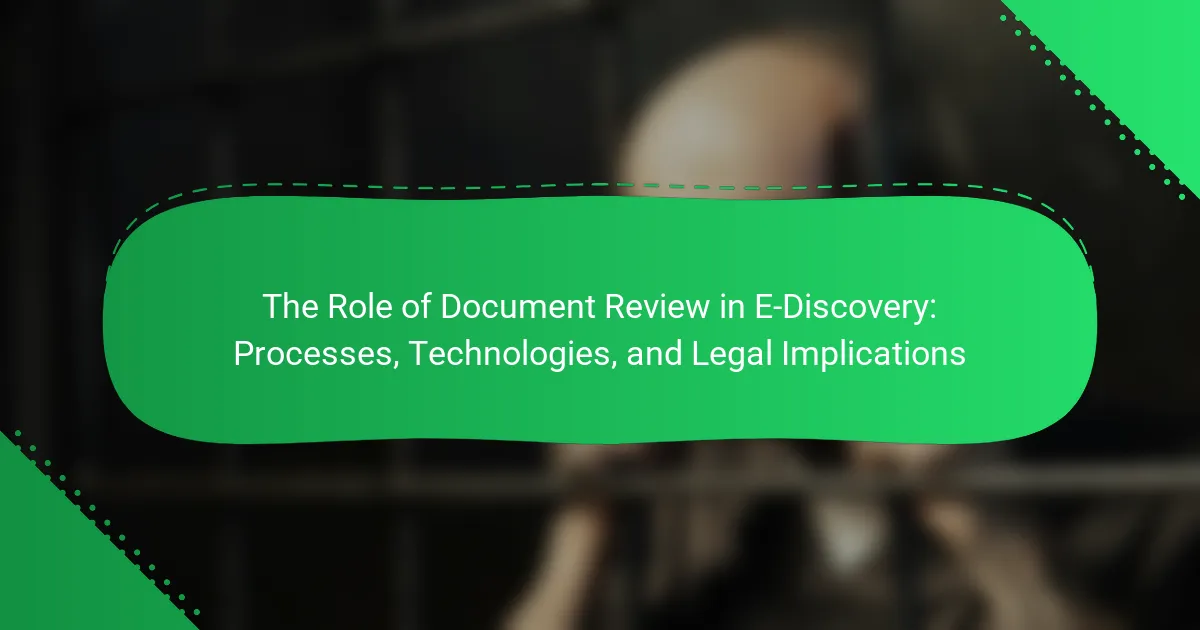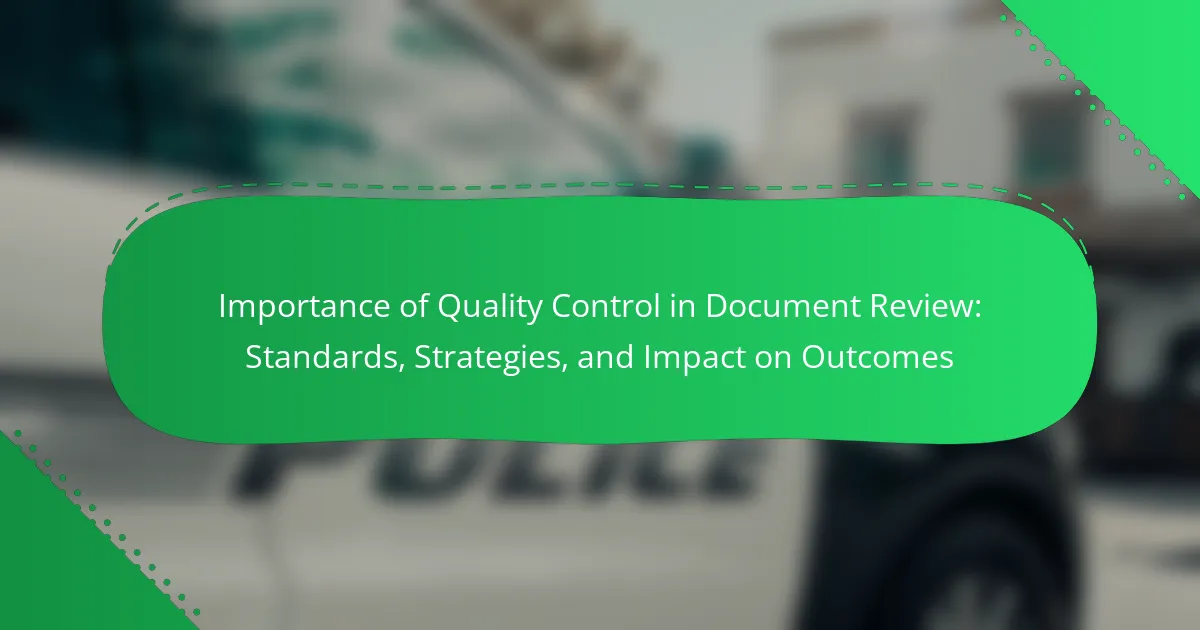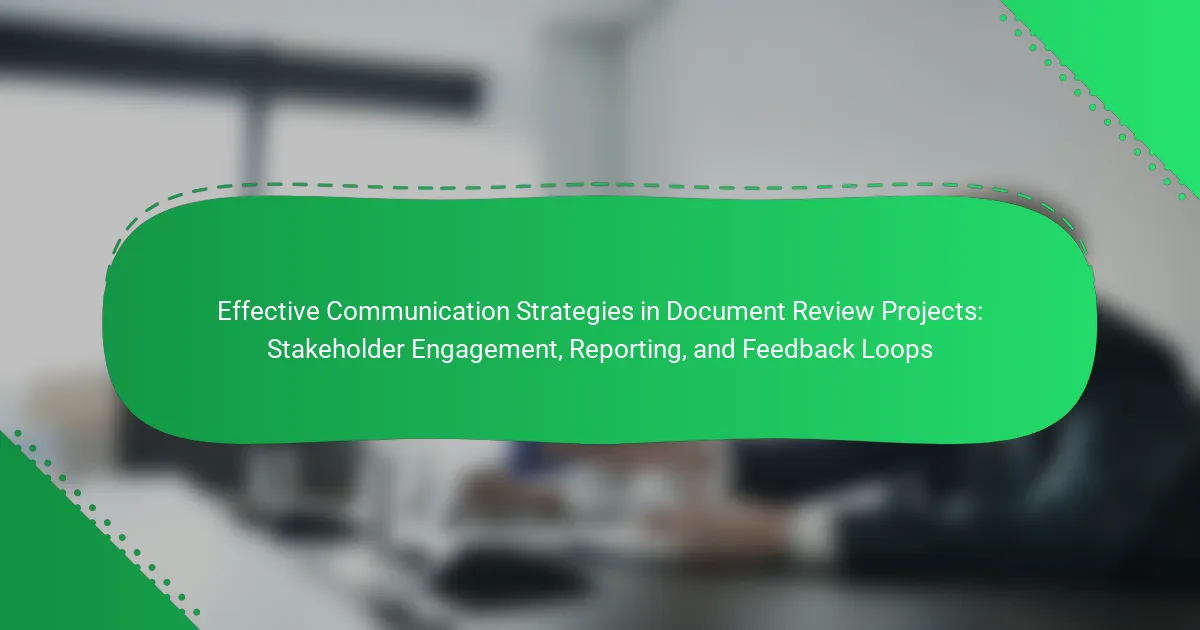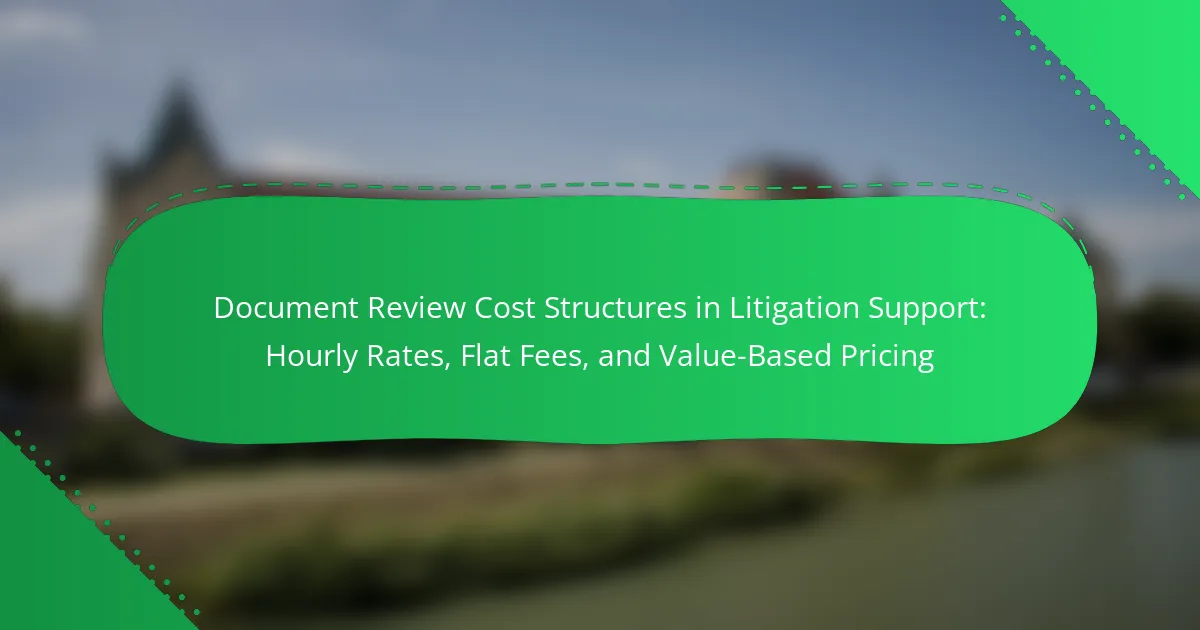Document review is a crucial process in e-discovery, involving the analysis of electronic documents to identify relevant information for legal cases. This process is essential for ensuring compliance with legal standards and developing effective case strategies. The review can be conducted manually or with the aid of advanced technologies such as machine learning and artificial intelligence, which enhance the identification and categorization of documents. Key aspects include the assessment of relevance and privilege, adherence to regulations, and the management of sensitive information to prevent legal liabilities. Understanding the role of document review in e-discovery is vital for legal teams to navigate the complexities of litigation efficiently and effectively.
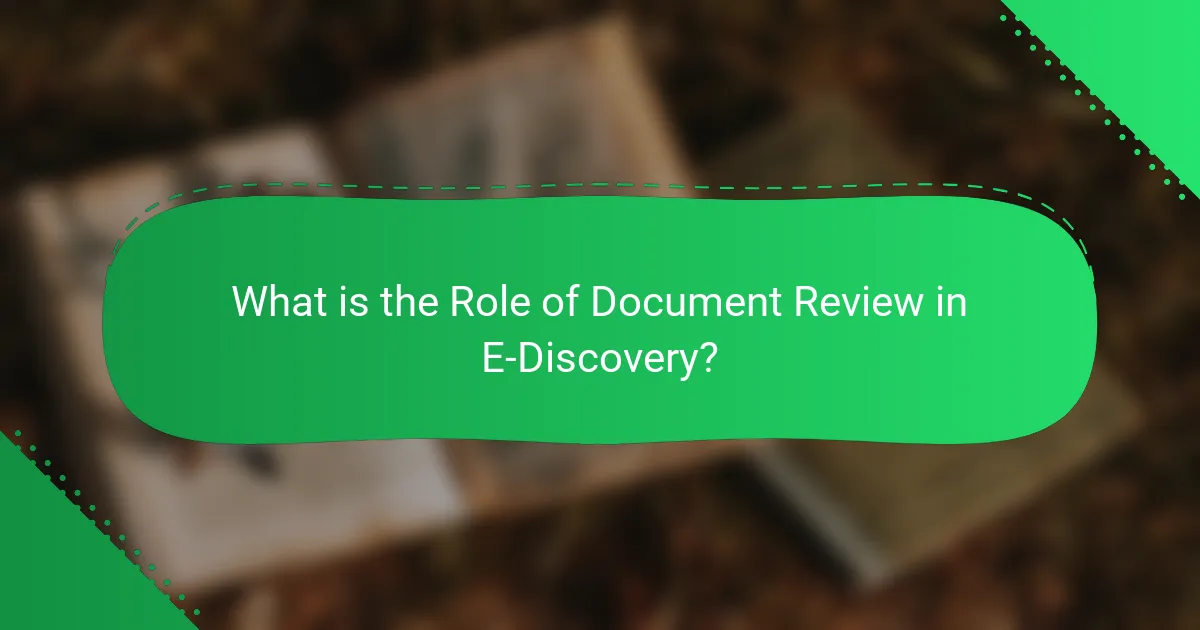
What is the Role of Document Review in E-Discovery?
Document review is a critical process in e-discovery. It involves analyzing electronic documents to identify relevant information for legal cases. This process ensures compliance with legal standards and helps in building a case strategy. Document review can be performed manually or through automated tools. The goal is to categorize documents as relevant, privileged, or non-relevant. According to the Federal Rules of Civil Procedure, parties must disclose relevant documents during discovery. Effective document review can significantly reduce litigation costs and time. It also aids in risk management by identifying potential legal issues early.
How does Document Review fit into the E-Discovery process?
Document review is a critical phase in the e-discovery process. It involves the examination of electronically stored information (ESI) to identify relevant documents for legal cases. During this phase, legal teams assess documents for privilege, relevance, and confidentiality. This ensures compliance with legal standards and protects sensitive information. Document review can be conducted manually or through automated tools. Automation increases efficiency and accuracy in identifying pertinent data. The results of document review directly influence case strategy and outcomes. Thus, it is essential for effective e-discovery and legal preparedness.
What are the stages of Document Review in E-Discovery?
The stages of Document Review in E-Discovery include identification, collection, processing, review, analysis, and production. Identification involves determining which documents are relevant to the case. Collection refers to gathering these documents from various sources. Processing includes converting documents into a reviewable format. Review is the stage where legal teams assess the relevance and privilege of documents. Analysis involves categorizing and summarizing findings from the review. Finally, production is the sharing of relevant documents with opposing parties or the court. Each stage is crucial for ensuring compliance with legal standards and effective case management.
How does Document Review impact case outcomes in E-Discovery?
Document review significantly impacts case outcomes in E-Discovery by determining the relevance and admissibility of evidence. Effective document review identifies key documents that support or undermine legal arguments. It ensures compliance with legal standards and reduces risks of sanctions. A thorough review can uncover critical information that influences settlement negotiations. Studies indicate that cases with comprehensive document reviews have higher success rates. For instance, a report by the Electronic Discovery Reference Model found that 70% of cases with diligent document review resulted in favorable outcomes. Thus, document review plays a crucial role in shaping the trajectory of legal cases in E-Discovery.
Why is Document Review essential in legal proceedings?
Document review is essential in legal proceedings because it identifies relevant evidence. This process involves examining documents to extract information pertinent to a case. Legal professionals analyze these documents to build arguments or defenses. Proper document review ensures compliance with legal standards. It also minimizes risks of overlooking critical information. According to the Federal Rules of Civil Procedure, parties must disclose relevant documents. This requirement underscores the importance of thorough document review in litigation. Effective document review can significantly impact the outcome of a case.
What legal standards guide Document Review practices?
Legal standards guiding Document Review practices include the Federal Rules of Civil Procedure (FRCP). The FRCP outlines expectations for the discovery process in federal courts. Specific rules, such as Rule 26, emphasize proportionality and relevance in document production. Courts require parties to engage in good faith efforts during document review. The standards also address privilege and confidentiality concerns. Case law, such as Zubulake v. UBS Warburg, highlights the importance of reasonable search efforts. Compliance with these standards is crucial to avoid sanctions. Thus, adherence to the FRCP and relevant case law shapes effective Document Review practices.
How does Document Review contribute to compliance and risk management?
Document review is essential for ensuring compliance and managing risk within organizations. It involves systematically examining documents to ensure they meet legal and regulatory standards. This process helps identify potential compliance issues before they escalate into legal problems. Regular document review mitigates risks by uncovering discrepancies and ensuring adherence to policies. For instance, a study by the Association of Corporate Counsel found that 70% of organizations that implement thorough document review processes experience fewer compliance violations. Document review also aids in maintaining accurate records, which is crucial for audits and regulatory inspections. By proactively addressing compliance concerns, organizations can avoid costly penalties and reputational damage.
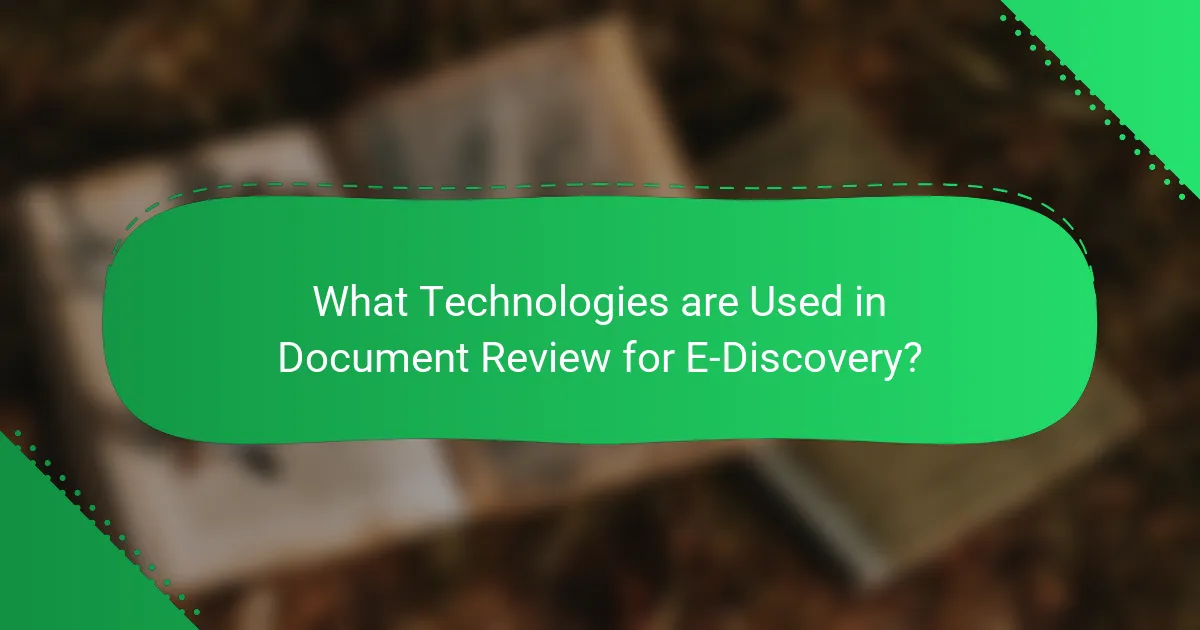
What Technologies are Used in Document Review for E-Discovery?
Technologies used in document review for e-discovery include advanced data analytics, machine learning, and artificial intelligence. These technologies facilitate the identification and categorization of relevant documents. Predictive coding is a notable machine learning technique that automates document review. It analyzes previously reviewed documents to predict relevance in new data sets. Optical character recognition (OCR) converts scanned documents into searchable text. This enhances the ability to locate specific information within large volumes of data. Additionally, cloud-based platforms enable secure collaboration and storage of documents. These technologies streamline the review process and improve efficiency in legal investigations.
How do modern technologies enhance Document Review?
Modern technologies enhance document review by streamlining processes and improving accuracy. Advanced software automates the identification and categorization of relevant documents. Machine learning algorithms analyze large datasets quickly, reducing manual review time. Natural language processing tools extract key information from documents efficiently. These technologies minimize human error and increase consistency in reviews. According to a study by the American Bar Association, technology-assisted review can reduce document review costs by up to 50%. Additionally, cloud-based platforms enable real-time collaboration among legal teams. Overall, these innovations significantly boost productivity and effectiveness in document review processes.
What are the key tools and software for Document Review?
Key tools and software for document review include Relativity, Logikcull, and Everlaw. Relativity is widely used for its scalability and powerful analytics features. Logikcull offers a user-friendly interface and automated document organization. Everlaw combines document review with collaboration tools for legal teams. These platforms streamline the review process and enhance efficiency. They also provide features like tagging, searching, and reporting. The adoption of such tools improves accuracy and reduces review time significantly.
How do artificial intelligence and machine learning assist in Document Review?
Artificial intelligence and machine learning enhance document review by automating the analysis of large volumes of data. These technologies can quickly identify relevant documents based on specific criteria. They use algorithms to categorize and prioritize documents for review. Machine learning models improve their accuracy over time by learning from user interactions and feedback. AI can also detect patterns and anomalies in documents that might be missed by human reviewers. Studies have shown that AI can reduce review time by up to 70%. This efficiency leads to significant cost savings in e-discovery processes.
What challenges do legal professionals face during Document Review?
Legal professionals face several challenges during document review. One major challenge is the sheer volume of documents that need to be reviewed. In complex cases, this can reach thousands or even millions of documents. Time constraints often exacerbate this issue, as legal teams must meet tight deadlines. Additionally, identifying relevant documents requires a deep understanding of the case specifics.
Another challenge is the potential for human error. Manual reviews can lead to missed critical information or misinterpretations. The complexity of legal language and terminology further complicates the review process. Furthermore, maintaining confidentiality and data security is essential, as sensitive information is often involved.
Finally, integrating technology into document review presents its own set of challenges. While e-discovery tools can streamline the process, they may also require specialized training. Legal professionals must balance the use of technology with traditional review methods to ensure thoroughness and accuracy.
How do data volume and complexity affect Document Review processes?
Data volume and complexity significantly impact Document Review processes. High data volume can overwhelm reviewers, leading to increased time and costs. Complex data structures complicate the extraction of relevant information. Reviewers may struggle to identify pertinent documents amid vast amounts of data. Additionally, complexity can hinder the application of automated tools. These tools often rely on clear data formats for effective processing. A study by the RAND Corporation found that larger document sets require more resources, influencing overall efficiency. Therefore, managing both volume and complexity is crucial for effective Document Review in e-discovery.
What are the common pitfalls in Document Review that must be avoided?
Common pitfalls in Document Review include inadequate planning and lack of clear objectives. Inadequate planning can lead to missed deadlines and overlooked documents. Lack of clear objectives results in inefficient use of resources. Overlooking relevant documents is a frequent issue. This can happen due to poor keyword selection in searches. Insufficient training for reviewers can also lead to errors. Reviewers may misinterpret documents without proper guidance. Additionally, failure to maintain effective communication among team members can hinder progress. All these pitfalls can significantly impact the outcome of the document review process.
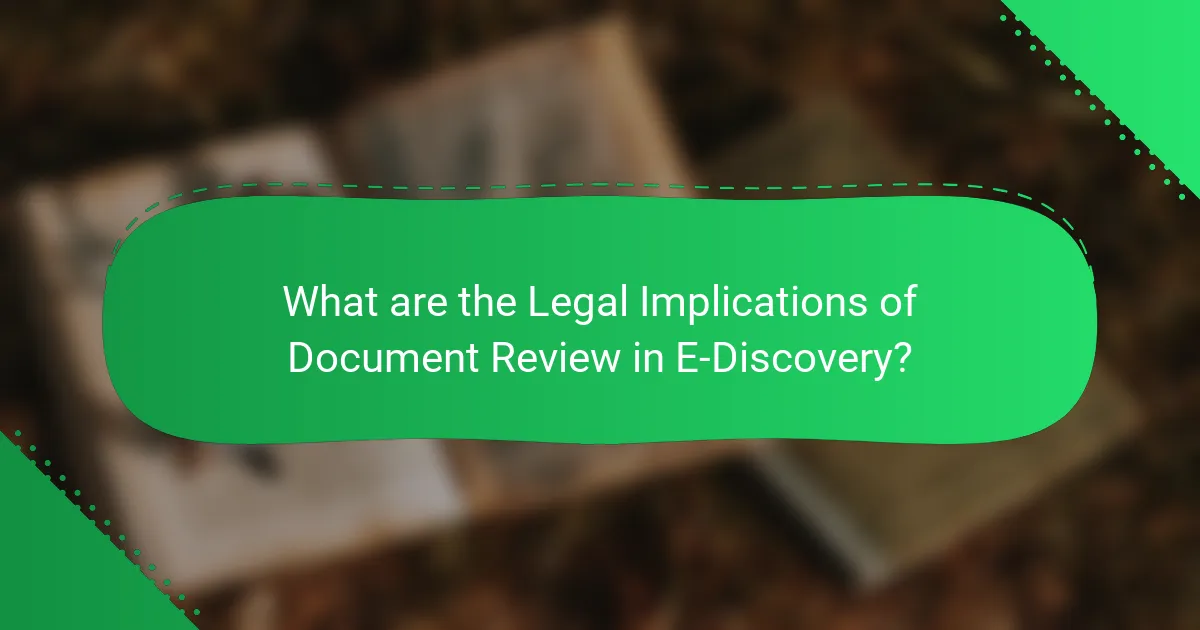
What are the Legal Implications of Document Review in E-Discovery?
Document review in e-discovery has significant legal implications. It involves assessing documents for relevance and privilege. Legal teams must comply with regulations and case law. Failure to do so can result in sanctions or adverse judgments. The attorney-client privilege must be maintained during this process. Mismanagement of sensitive information can lead to legal liabilities. Courts expect transparency and good faith in document review efforts. Proper documentation of the review process is essential for legal protection.
What are the ethical considerations in Document Review?
Ethical considerations in document review include confidentiality, accuracy, and impartiality. Confidentiality requires protecting sensitive information from unauthorized access. Reviewers must ensure that any privileged or confidential documents remain secure. Accuracy involves thoroughly analyzing documents to avoid misinterpretation. Misinterpretation can lead to incorrect conclusions or legal consequences. Impartiality is essential to maintain fairness in the review process. Reviewers should not allow personal biases to influence their assessments. Compliance with legal standards also plays a critical role. Adhering to relevant laws ensures the integrity of the document review process. These ethical considerations are crucial for maintaining trust and credibility in e-discovery.
How do confidentiality and privilege issues arise in Document Review?
Confidentiality and privilege issues arise in document review primarily through the handling of sensitive information. During the review process, legal teams assess documents for relevance and confidentiality. They must identify privileged communications, which are protected from disclosure under attorney-client privilege. Misclassification of documents can lead to unintentional breaches of confidentiality. Additionally, improper sharing of sensitive information may violate legal and ethical standards. The risk of exposure increases when multiple reviewers access the same documents. Implementing strict protocols and training can mitigate these risks. Accurate labeling and secure access controls are essential to maintaining confidentiality and privilege during document review.
What are the consequences of improper Document Review practices?
Improper document review practices can lead to significant legal and financial repercussions. These practices may result in missed critical evidence, which can weaken a case. Inaccurate or incomplete reviews can also lead to sanctions from courts. For example, a failure to identify privileged documents may result in their inadvertent disclosure. This can damage client confidentiality and trust. Additionally, improper reviews can increase litigation costs due to extended timelines and additional resources needed. According to a study by the Association of Corporate Counsel, 55% of legal departments reported increased costs due to poor document management. Ultimately, these consequences can adversely affect a firm’s reputation and client relationships.
How can organizations optimize their Document Review processes?
Organizations can optimize their Document Review processes by implementing technology-driven solutions. Utilizing advanced software can enhance efficiency and accuracy. Tools like artificial intelligence can quickly analyze large volumes of documents. This technology reduces the time needed for manual reviews. Additionally, establishing clear guidelines for document categorization improves consistency. Regular training for reviewers ensures they are updated on best practices. Collaboration among teams can lead to better insights and shared knowledge. Tracking metrics on review performance helps identify areas for improvement. These strategies collectively enhance the overall effectiveness of Document Review in E-Discovery.
What best practices should be followed in Document Review for E-Discovery?
Best practices in document review for e-discovery include establishing a clear review protocol. This protocol should define the scope and objectives of the review. Additionally, utilizing technology for document management enhances efficiency. Review teams should be trained in relevant legal standards and document handling procedures. Regular quality control checks must be implemented to ensure accuracy. Communication among team members is vital for consistency. A defensible process should be documented to support legal compliance. These practices help in managing large volumes of data effectively and reduce the risk of oversight.
How can training and resources improve Document Review efficiency?
Training and resources can significantly improve Document Review efficiency by enhancing the skills and knowledge of reviewers. Well-structured training programs equip reviewers with the necessary techniques for identifying relevant information quickly. Resources such as templates and checklists streamline the review process and ensure consistency. Access to advanced technologies, like AI tools, further accelerates document analysis. Studies indicate that organizations investing in training can reduce review time by up to 30%. Improved efficiency leads to cost savings and better compliance with legal standards.
The primary entity in this article is Document Review, a critical process in e-discovery that involves analyzing electronic documents to identify relevant information for legal cases. The article provides a comprehensive overview of the document review process, including its stages, impact on case outcomes, and the technologies that enhance efficiency, such as artificial intelligence and machine learning. It also addresses the legal implications and ethical considerations associated with document review, emphasizing the importance of compliance and risk management. Additionally, the article outlines best practices and strategies for optimizing document review processes within organizations.
